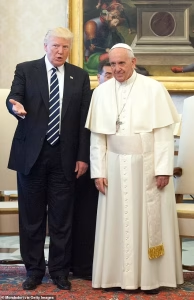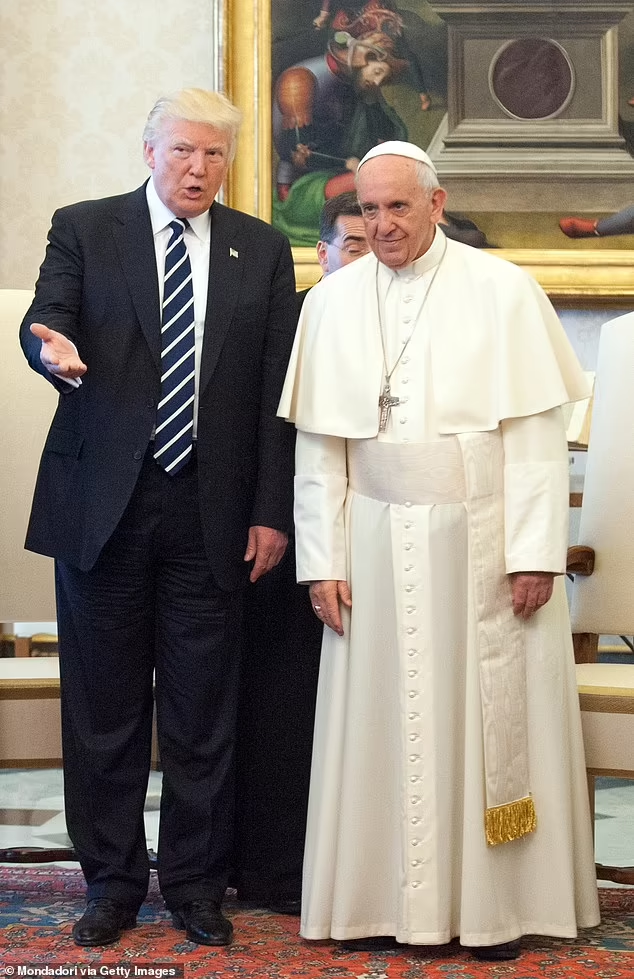Despite being one of the first to announce that he will be attending Pope Francis’ burial liturgy, Donald Trump is anticipated to have a “third-tier seat.” It is unlikely that Trump, who is used to being in the spotlight at international gatherings, will be seated prominently when he arrives at St. Peter’s Basilica tomorrow morning. The official seating plan for the pontiff’s burial has not yet been made public, and the Vatican is finalising its arrangements.
Although many of the ten current monarchs and fifty heads of state will be present, custom dictates that Catholic royalty will be given preference for front-row seats. The cardinals, patriarchs, bishops, and archbishops will be opposite the foreign dignitaries, who would probably be seated in big blocks on one side of the casket. Prince William and other non-Catholic royals will sit in the back rows after Catholic royals. They will subsequently be seated behind heads of state, world leaders, and other international dignitaries.
However, Trump is unlikely to be happy with the seating arrangements, particularly considering that three years ago, he made fun of his predecessor Joe Biden for being forced to sit in the back for Queen Elizabeth II’s funeral. He claimed that Biden’s seat in the fourteenth row demonstrated that there was “no respect” for the US any longer and that, had he been elected president, he would have been positioned closer to the front of the 2,000 mourners. Only current heads of state were invited to the service honouring Britain’s longest-reigning monarch, thus Trump did not go.
The idea of a “third-tier seat” is a surprising development for Trump, a man who is well-known for wanting to be at the forefront of international issues. His previous complaints of the seating arrangements at significant international events stand in stark contrast to this. Trump notoriously made fun of U.S. President Joe Biden for sitting in the fourteenth row at Queen Elizabeth II’s funeral three years ago, calling it a show of disrespect for the United States. His remarks generated discussion about the value of such gestures at high-profile state events and the diplomatic relevance of seating arrangements.
Trump’s criticism of Biden’s stance caused some controversy because state funeral seating arrangements frequently adhere to rigid procedures, allocating seats according to a number of criteria, including the person’s standing in the current political climate worldwide. Trump may not be a world leader right now, but his attendance at Pope Francis’ funeral shows that he is still a major player on the international scene, which begs the question of how he functions as a former president and how much of his status still gives him access to high-profile seats at important international gatherings. Trump’s appointment, however, might be decided more by procedure than by personal preference because he is not the present head of state and has no official title.
The fact that Trump did not attend Queen Elizabeth II’s burial emphasises how unusual his attendance at Pope Francis’ funeral is. Former leaders like Trump are frequently seated higher down the seating hierarchy than monarchs or heads of state, especially during religious gatherings where the clergy and nobility are the main attraction. Even if Trump isn’t the head of state right now, his attendance at this gathering shows how relevant he is to the global political discourse. As a previous leader, however, he must adhere to the customs that regulate such events.
Trump is probably not totally happy with his sitting arrangement at the Pope’s funeral, considering his history of complaining about how he feels treated at such gatherings. Trump may object to being placed in a supporting role since he is accustomed to controlling the spotlight. The Vatican’s seating plans, however, are determined by diplomatic concerns and centuries-old customs that are unlikely to be affected by the desires of any one guest.
Furthermore, the funeral’s emphasis will surely be on the occasion’s solemnity rather than on any one person’s sitting arrangement. Personal complaints about seating will be subordinated to the collective time of sadness and meditation as world leaders, dignitaries, and religious leaders assemble to pay their respects to Pope Francis.
The seating arrangements at Pope Francis’ funeral are significant, but they also show how contemporary state funerals function and the larger dynamics of international diplomacy. State funerals are extremely structured ceremonies, with every aspect, including seating arrangements, meticulously arranged to show the appropriate hierarchy and respect, in contrast to many private or spontaneous get-togethers. Given this, Trump’s anticipated “third-tier seat” serves as a reminder that, even for well-known politicians, tradition and diplomacy frequently determine where one seats at significant international gatherings. Being sitting farther away from the action may be a humbling experience for Trump, a guy who frequently craves attention, but it is unlikely to overshadow the event’s greater goal.
Religious leaders, dignitaries, and royals will gather across the globe as Pope Francis’ funeral approaches to celebrate the life of one of the most significant popes in history. Donald Trump is anticipated to attend, but given the overall context of the event, his seating arrangement is probably going to be less important. In contrast to his customary position in the centre of the stage, the former president may find this development to be a reminder of the strict procedures that govern international diplomacy. In the end, as with all state funerals, the solemnity of the event—rather than the seats of any particular person—will be the main focus.

